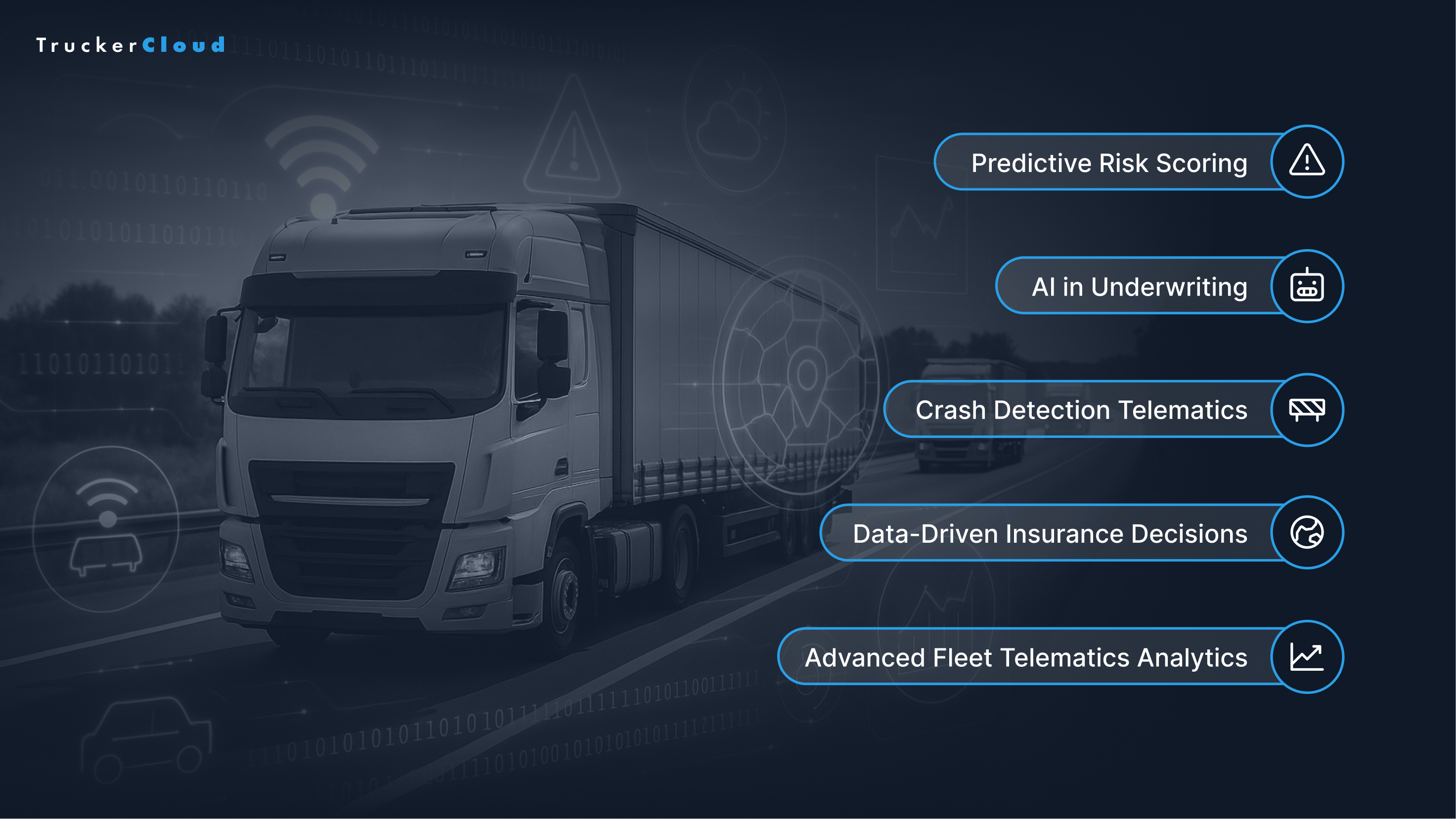What’s Next in Telematics and Usage-Based Auto Insurance: 5 Predictions for the Next 5 Years
The world of telematics and usage-based auto insurance is evolving faster than ever. What once was a novel way to tailor policies based on driver behavior and mileage has become an essential part of commercial fleet insurance strategies. At TruckerCloud, we’ve seen how these innovations transform risk assessment, claims processing, and fleet management. But what does the future hold? Here are five telematics and usage-based auto insurance trends we expect to shape the industry over the next five years.

1. Predictive Risk Scoring Will Improve Fleet Insurance Pricing
Predictive risk scoring will revolutionize how insurers evaluate and price policies for commercial fleets. By combining telematics data with external factors such as weather, traffic patterns, and vehicle maintenance records, insurers can forecast claims more accurately.
These predictive models use sophisticated algorithms and machine learning to spot hidden risks that traditional underwriting methods might miss. By combining telematics with behavioral risk models, insurers will be able to assess driver behavior patterns over time, flagging those with higher probabilities of accidents or violations.
The impact will be twofold: Fleets will get fairer premiums based on their real risk, and insurers will cut down on surprise claims. This shift to predictive analytics will help differentiate commercial fleet insurance providers in a competitive market.
2. AI in Insurance Underwriting Will Accelerate Decision-Making and Personalization
Artificial intelligence is driving big changes in insurance. AI-powered underwriting will evolve from automating tasks to supporting complex decisions, combining telematics with other data sources.
A key advance will be AI's ability to combine ELD (Electronic Logging Device) data with telematics, analyzing driving hours, rest periods, and compliance to improve risk assessment for fleets. This helps insurers meet regulations and offer better rates to safe, compliant fleets.
AI-powered underwriting systems will enable personalized insurance products tailored to the unique profiles of individual fleets. For example, fleets with strong safety records or efficient routes could unlock discounts or rewards. Faster decisions will make getting coverage quicker, helping fleet operators find plans that fit their needs.
Faster and more accurate underwriting decisions will streamline the insurance purchasing experience, making it easier for commercial operators to find coverage that fits their needs.
3. Crash Detection Will Improve Claims and Driver Safety
Crash detection telematics will become a game-changer in managing insurance claims and improving driver safety. Sensors that instantly spot collisions or near-misses can automatically alert insurers and emergency services, speeding up responses and claims processing.
By providing immediate, accurate crash data, these telematics systems allow insurance companies to verify claims quickly and reduce fraud. In turn, fleets benefit from faster claim resolutions and lower downtime for vehicles involved in incidents.
Beyond claims, crash detection systems offer preventive benefits. Alerts triggered by risky maneuvers or unsafe conditions can warn drivers in real time, encouraging safer behavior. Coupled with ongoing telematics monitoring, these technologies will support the development of dynamic feedback loops where drivers receive coaching to reduce future risks.
4. Data-Driven Insurance Decisions Will Look Beyond Basic Metrics
In the coming years, telematics will expand beyond mileage and speed tracking to encompass a wide array of contextual information. Insurers will factor in weather, road conditions, traffic, and even driver health indicators or vehicle reports.
For instance, insurers may begin integrating weather data, road conditions, and traffic congestion patterns to better understand the context behind telematics readings. This approach will help avoid penalizing drivers for circumstances outside their control and reward proactive risk management.
Wearables and biometric sensors could feed driver fatigue and stress levels into telematics systems. Understanding human factors will be key to developing holistic insurance models that promote wellness and safety alongside traditional vehicle metrics.
Combining telematics with IoT and cloud computing will create new ways for insurers and fleets to team up on risk reduction and efficiency.
5. Advanced Fleet Telematics Analytics Will Drive Smarter Insurance Models
As fleet data grows, advanced telematics analytics will become standard for precise risk assessment. The integration of fleet telematics analytics will become standard practice, providing insurers with a granular view of vehicle and driver performance. This means underwriting processes will increasingly rely on rich datasets rather than broad categorizations.
In practice, insurers will use analytics not just to track miles driven or speeding events but also to evaluate patterns such as harsh braking, cornering, and idling times. These detailed insights will allow insurers to offer usage-based commercial auto insurance product that better align premiums with actual risk.
The adoption of advanced telematics analytics tools will also benefit fleets. With real-time data, fleet managers can improve driver training, optimize routes, and reduce maintenance costs. This shared focus on data will strengthen partnerships between insurers and fleet operators.
Wrapping Up: What’s Next for Telematics and Usage-Based Auto Insurance
As these telematics and usage-based auto insurance trends unfold, commercial fleets and insurance providers alike must adapt to a rapidly changing landscape. The next five years promise greater precision in risk scoring, smarter underwriting powered by AI, and enhanced safety through real-time crash detection.
At TruckerCloud, we specialize in providing cutting-edge fleet telematics analytics solutions that empower fleets to leverage these innovations. Our platform integrates seamlessly with insurance providers to optimize usage-based commercial auto insurance programs, helping fleets reduce risk, improve safety, and secure better rates.
Stay ahead of the curve by partnering with TruckerCloud.Reach out todayto discover how our telematics expertise can transform your insurance strategy and fleet operations.



